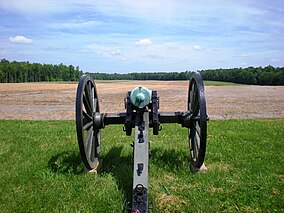

| Richmond National Battlefield Park | |
|---|---|

Union gun position at Malvern Hill
| |
|
Show map of Virginia
Show map of the United States | |
| Location | Richmond, Hanover County, Henrico County, Chesterfield County, Virginia, USA |
| Nearest city | Richmond, Virginia |
| Coordinates | 37°25′45″N 77°22′25″W / 37.42917°N 77.37361°W / 37.42917; -77.37361 |
| Area | 8,168.87 acres (33.0582 km2)[1] |
| Established | March 2, 1936[2] |
| Visitors | 94,967 [3] (in 2016) |
| Governing body | National Park Service |
| Website | Richmond National Battlefield Park |
Richmond National Battlefield Park | |
| NRHP reference No. | 66000836 [4] |
| VLR No. | 043-0033 |
| Significant dates | |
| Added to NRHP | October 15, 1966 |
| Designated VLR | January 16, 1973[5] |
The Richmond National Battlefield Park commemorates 13 American Civil War sites around Richmond, Virginia, which served as the capital of the Confederate States of America for most of the war. The park connects certain features within the city with defensive fortifications and battle sites around it.
Virginia voted to secede from the United States in May 1861, and became part of the Confederacy. As a major manufacturing centre, Richmond was soon chosen to be the Confederate capital. The environs of the city would witness much combat over the next four years.
Richmond National Battlefield Park occupies almost 3000 acres in the coastal plain of Virginia, bounded by the James and Chickahominy River watersheds, much of it preserved as it would have looked in the Civil War, with scenic meadows and old-growth forest enabling abundant wildlife.[6][7]
The chief ironworks of the Confederacy, and a big factor in the decision to make Richmond its capital. It supplied about half the artillery used by the Confederate States Army. Visitors centre and Civil War museum, National Park Service Rangers, interactive theaters, plasma-screen maps.
The Confederacy's biggest hospital camp, accommodating up to 4000 patients at a time, mainly for convalescence. Museum with surgical and medical displays, filmshow.
This was McClellan’s attempt to attack Richmond from the east, via the James River. Although obstructed by Confederate artillery, he managed to approach within four miles of the city, but was stopped in a surprise attack by General Joseph E. Johnston.
A rapid sequence of battles (sometimes reckoned as part of the Peninsula Campaign), initiated by the newly-appointed Confederate commander Robert E. Lee. McClellan soon had to retreat, but Lee failed in his plan to cut-off the Union army.[8]
InU.S. Grant’s first campaign as General-in-Chief, he operated in the field, alongside the army commander George Meade. It started with a standoff at the Battle of the Wilderness, followed by two defeats at Spotsylvania Court House and Cold Harbor.
After his reverses in the Overland Campaign, U.S. Grant settled into a siege, where he could bring his superior numbers to bear on Lee's over-stretched and starving Confederates. When Petersburg fell, the early surrender of Richmond was inevitable.[9]
|
| ||
|---|---|---|
| Lists by county |
| |
| Lists by city |
| |
| Other lists |
| |
| ||
| International |
|
|---|---|
| National |
|
| Other |
|